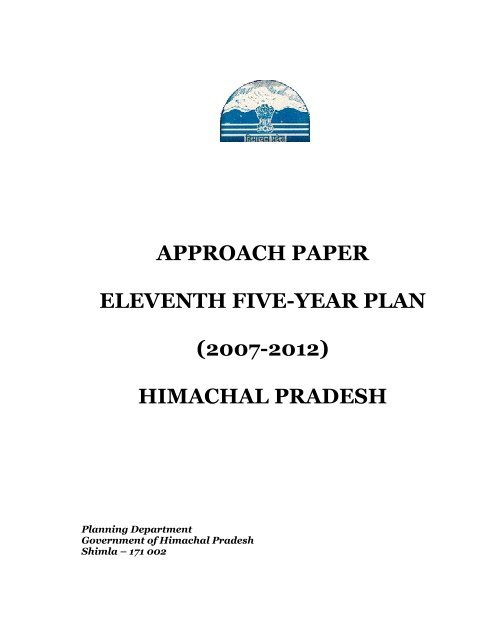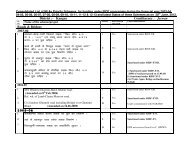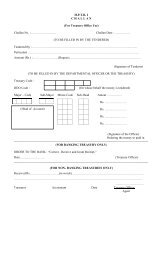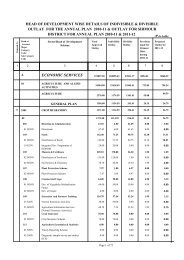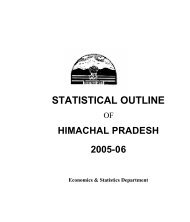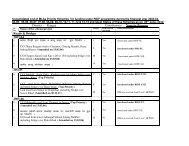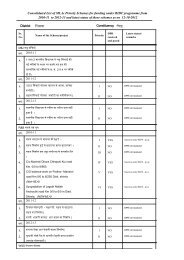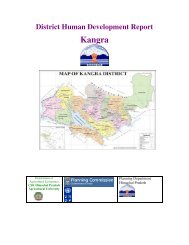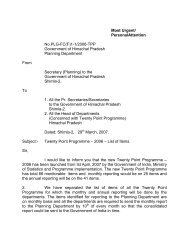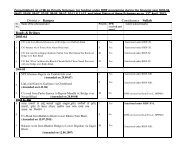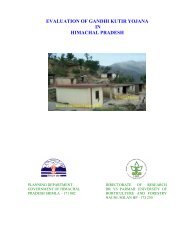Approach Paper to Eleventh Five-Year Plan for H.P. - Planning ...
Approach Paper to Eleventh Five-Year Plan for H.P. - Planning ...
Approach Paper to Eleventh Five-Year Plan for H.P. - Planning ...
- No tags were found...
Create successful ePaper yourself
Turn your PDF publications into a flip-book with our unique Google optimized e-Paper software.
concentrate on accelerating agricultural growth. The twinobjectives would be <strong>to</strong> increase the incomes from farming andallied activities and the employment opportunities within thissec<strong>to</strong>r. The emphasis will be on modernization of agriculture/horticulture practices so as <strong>to</strong> increase the farm productivityand accelerating diversification of agriculture <strong>to</strong>wards highvalue crops.18. The framework <strong>for</strong> opening up of the farm sec<strong>to</strong>r <strong>for</strong>contract farming as also <strong>for</strong> organic farming has been put inplace. The focus shall also be on improvement of irrigationfacilities, facilitation of effective market linkages, adequatecredit, fertilizer, high quality seeds and other inputs. Researchand extension work would also need <strong>to</strong> be suitably supported.All this is expected <strong>to</strong> lead <strong>to</strong> substantial value addition in thissec<strong>to</strong>r.19. The <strong>to</strong>tal geographical area of Himachal Pradesh is 55.67lakh hectares. Only 10.47% of this area, i.e. 5.83 lakh hectaresis the net sown area. It is estimated that the ultimate irrigationpotential is 3.35 lakh hectares i.e. 57% of the net sown area.Currently, a <strong>to</strong>tal culturable command area of 2.07 lakh hectarehas irrigation access. The vision <strong>for</strong> the eleventh plan is <strong>to</strong>maximize irrigation sources <strong>for</strong> the balance 38% irrigationpotential of 1.28 lakh hectares. The State Government hasalready prepared a blue print <strong>for</strong> bringing an additional 98,000hectares under irrigation through the Bharat NirmanProgramme. Ongoing irrigation projects are being prioritised<strong>for</strong> speedy completion. Water conservation technologies willalso be propagated <strong>for</strong> increasing farm productivity.20. The State Government is acutely aware of the existing gapbetween irrigation potential created and its utilization.Bridging this gap will be accorded high priority during the<strong>Eleventh</strong> <strong>Plan</strong> through farmers’ associations and extensionwork by the agriculture and horticulture departments.7
21. For meeting all these objectives, the State Governmentenvisages an investment of Rs. 2000 crore in the farm andirrigation sec<strong>to</strong>r, during the <strong>Eleventh</strong> <strong>Plan</strong>.EDUCATION22. The 2001 census enumerated the literacy rate of HimachalPradesh as 76 per cent with male literacy rate at 85 per centand female literacy rate at 67 per cent. Thereafter, HimachalPradesh has made further rapid strides <strong>to</strong>wards universalelementary education, which has resulted in almost 100%literacy among the youth of this State.23. At the start of the <strong>Eleventh</strong> <strong>Five</strong> <strong>Year</strong> <strong>Plan</strong>, the overallliteracy rate is estimated <strong>to</strong> be around 88 per cent, with maleliteracy rate at 94 per cent and female literacy rate at 82 percent. The gains in literacy will now come at a slower pacebecause of the overall demographic trends of HimachalPradesh. The projections are <strong>to</strong> achieve a literacy rate of morethan 92 per cent by the end of the <strong>Eleventh</strong> <strong>Plan</strong>.24. Despite the fact that Chamba, Kullu and Sirmour districtswere covered under earlier central programs <strong>for</strong> universalprimary education, these districts still have literacy rates muchbelow the State average. With the goal of inclusive growth anddevelopment, special attention shall be paid <strong>to</strong> increase theliteracy rates of these districts. The earlier literacy gains inthese districts will be taken <strong>for</strong>ward under ‘Sarva ShikshaAbhiyan’, through area/target group interventions.25. As a specific gender issue, by continuing all programs <strong>for</strong>universal education and ensuring suitable interventions <strong>to</strong>minimize the drop out rates <strong>for</strong> the girl child, the goal shall be<strong>to</strong> achieve a female literacy rate of at least 88%, by the end ofthe <strong>Eleventh</strong> <strong>Plan</strong>.8
the population growth rate of Himachal Pradesh would be only1 per cent per annum.31. Above trends of population growth augur well <strong>for</strong>Himachal Pradesh <strong>to</strong> reap the benefits of the ‘sweet spot’ of thedemographic transition, with larger labour participation ratesleading <strong>to</strong> higher saving rates. To translate in<strong>to</strong> faster growthrates, such savings need greater opportunities <strong>for</strong> investmentwithin Himachal. To fully benefit from the ‘sweet spot’, it isimperative that we also specifically plan <strong>for</strong> enhancedemployment opportunities <strong>for</strong> the increased working agepopulation.32. Since more than 90 per cent of Himachal population isrural, a paramount health and welfare objective is <strong>to</strong> ensuresafe drinking water <strong>for</strong> all villages. For this purpose, the<strong>Eleventh</strong> <strong>Plan</strong> interventions shall be suitably integrated withthe accelerated rural water supply (ARWSP) scheme of BharatNirman. One of the most important links in the chain <strong>for</strong>improved quality of life is the need <strong>for</strong> sanitation. To meet suchneeds, the existing water supply systems will need <strong>to</strong> beaugmented. New water supply projects will also have <strong>to</strong>planned <strong>for</strong> higher per capita requirements.33. It is estimated that fulfillment of all <strong>Eleventh</strong> <strong>Plan</strong>objectives of this sec<strong>to</strong>r (and allied activities) would require<strong>to</strong>tal State plan investment of Rs. 2500 crore.RURAL CONNECTIVITY34. In the absence of any other meaningful transportinfrastructure, the entire economic activity of HimachalPradesh is critically dependent on the quality and reach of itsroad network. Over 90 per cent of Himachal Pradeshpopulation is rural, as compared <strong>to</strong> the all-India figure of 72per cent. Rural connectivity is, there<strong>for</strong>e, crucial <strong>for</strong> the peopleof Himachal Pradesh. The goal <strong>for</strong> the <strong>Eleventh</strong> <strong>Plan</strong> is <strong>to</strong>synergize with the Pradhan Mantri Gram Sadak Yojana, <strong>to</strong>10
ensure that by 2012 all villages of population more than 250are served by all weather roads. In this context, the norms ofPMGSY under Bharat Nirman need <strong>to</strong> be revised <strong>for</strong> the hillStates.35. Policy interventions are also urgently required <strong>for</strong>improving the quality of the State’s main arterial roads. Giventhe mountainous terrain and <strong>to</strong>pographical constraints ofHimachal Pradesh, this objective can only be sub-servedthrough substantial financial investments. Unlike the States inthe plains where the volumes of traffic make it eminentlypossible <strong>to</strong> attract private investment, such possibilities do notexist in the hill States. The existing viability gap fundingmechanisms are inadequate <strong>to</strong> attract private investment inroads and allied infrastructure in Himachal Pradesh.There<strong>for</strong>e, it becomes imperative that this criticalinfrastructure sec<strong>to</strong>r receives desired budgetary supportthrough the State plan.36. To properly manage the road network <strong>for</strong> the economicactivities in Himachal Pradesh (including <strong>to</strong>urism), it isestimated that the State’s <strong>to</strong>tal plan outlay <strong>for</strong> this sec<strong>to</strong>r shallhave <strong>to</strong> be pegged at Rs. 2,500 crore.DEMOCRATIC DECENTRALIZATION37. The District <strong>Plan</strong>ning committees are being constituted inall districts of Himachal Pradesh. Much of the planninginvestment will be finalized in consultation with thesecommittees. <strong>Plan</strong> resources shall also be placed at the disposalof the Panchayats/Local Bodies, as per the recommendationsof the Twelfth Finance Commission and the Third StateFinance Commission.11
38. Well planned urban growth of cities and <strong>to</strong>wns ofHimachal Pradesh is vital <strong>for</strong> the provision of essentialinfrastructure services. The requisite urban services <strong>for</strong> Shimlashall be provided through the initiatives of the Jawahar LalNehru Urban Renewal Mission. Essential infrastructureservices <strong>for</strong> the other <strong>to</strong>wns and cities of Himachal Pradesh willneed <strong>to</strong> be integrated in<strong>to</strong> the State <strong>Plan</strong> since the JNURMdoes not cover these other <strong>to</strong>wns.39. It is estimated that <strong>for</strong> promoting the ends ofdecentralized planning <strong>for</strong> the rural and urban localgovernments, a <strong>to</strong>tal provision of Rs. 500 crore will be requiredover the <strong>Eleventh</strong> <strong>Plan</strong> period.FORESTRY AND ENVIRONMENT40. Adequate <strong>for</strong>est cover in Himachal Pradesh is essential <strong>to</strong>minimize problems of floods and soil erosion. Such <strong>for</strong>est coveris essential not only <strong>for</strong> retention of precipitation but also <strong>to</strong>induce adequate and regular rainfall. Although 67% of thegeographical area of Himachal Pradesh is legally classified as‘<strong>for</strong>est area’, actual tree cover is not possible in this entire areabecause much of this legally classified area is above the treeline/incapable of sustaining <strong>for</strong>ests. The goal of the state is <strong>to</strong>ensure that 35.5 percent of the <strong>to</strong>tal geographical area of thestate is brought under <strong>for</strong>est and tree cover. The balance ‘<strong>for</strong>estarea’ would be managed as alpine pastures, snow peaks andwater bodies, glaciers, etc.41. The data on <strong>for</strong>est cover released by the remote sensingagencies indicates an increase in the <strong>for</strong>est cover in HimachalPradesh over the last two decades. This has resulted from aconscious decision of the State Government <strong>to</strong> completely bangreen commercial felling. This decision signifies enormous lossof revenue <strong>to</strong> the State Government. The State Governmentneeds specific compensation on this account. The TwelfthFinance Commission acknowledged this issue but provided12
only <strong>to</strong>ken amounts <strong>for</strong> the protection of <strong>for</strong>ests. For HimachalPradesh the annual maintenance provision is only Rs. 4 crore<strong>for</strong> the State’s vast <strong>for</strong>est of area of over 37,000 squarekilometers. Thus, it will be essential <strong>to</strong> considerably step up<strong>Plan</strong> investments <strong>for</strong> nurturing and preserving the <strong>for</strong>est coveras also the wild life sanctuaries.42. In addition <strong>to</strong> the various Centrally Sponsored Schemes<strong>for</strong> af<strong>for</strong>estation/ watersheds/ management of wild lifesanctuaries, it is estimated that <strong>to</strong>tal State plan requirements<strong>for</strong> this sec<strong>to</strong>r would be Rs. 1500 crore.EMPLOYMENT43. A vital thrust of the <strong>Eleventh</strong> <strong>Plan</strong> <strong>for</strong> Himachal Pradeshwill be <strong>to</strong> tackle the un-employment problem. This wouldrequire a holistic approach <strong>for</strong> rapid growth strategies in allsuch sec<strong>to</strong>rs which have good employment potential. Since themajority of the labour <strong>for</strong>ce is still in the primary sec<strong>to</strong>r whichcontributes only 22 per cent <strong>to</strong> the State domestic product, thechallenge is <strong>to</strong> find greater productive employment <strong>for</strong> thislabour <strong>for</strong>ce.44. The employment strategy will have <strong>to</strong> simultaneouslytarget the primary, manufacturing and services sec<strong>to</strong>rs. Theburgeoning educated youth of Himachal Pradesh would need<strong>to</strong> be groomed with specific skill sets, <strong>to</strong> meet the requirementsof the expanding service sec<strong>to</strong>rs, including IT enabled services,financial/banking services, <strong>to</strong>urism and hospitality, etc.Specifically, there shall be greater focus on the disadvantagedand economically challenged sections of the youth, <strong>to</strong> improvetheir skill sets through targeted training and education, so as <strong>to</strong>improve their employability.45. For purposes of enhancing rural employment, adequatelinkages would need <strong>to</strong> be built with the National RuralEmployment Guarantee Programme and the Swaran JayantiRozgar Yojna. It would be important <strong>to</strong> ensure that such rural13
employment programmes build durable rural infrastructureand enhance irrigation potential <strong>for</strong> increasing farmproductivity.46. To meet all such employment and general economic/socialwelfare services, we will need <strong>to</strong> provide <strong>for</strong> a <strong>to</strong>tal five yearoutlay of Rs.500 crore.ISSUES FOR CENTRAL SECTOR PLAN47. The present system of inter-State allocations ininvestment by the Railways Ministry needs <strong>to</strong> address thespecific requirements of Himachal Pradesh. The constructionof the Bhanupalli-Bilaspur-Beri line is important <strong>for</strong> theeconomy of the State. The Prime Minister had agreed <strong>to</strong>consider this project as a national priority. The standard<strong>for</strong>mulae <strong>for</strong> assessing the viability of such projects would need<strong>to</strong> be modified <strong>for</strong> this project, which is vital <strong>for</strong> the economy ofthe State.48. Himachal Pradesh is still not on the regular air-map ofIndia. It is important that the State capital is given a round theyear air link. Ministry of Civil Aviation is examining upgradeproposals <strong>for</strong> 35 non-metro airports through the in-housecapacity of AAI/PPP possibilities. Airports of the State capitalsshould get first priority under this program. The need <strong>to</strong>upgrade the existing airstrip at Shimla is vital <strong>for</strong> <strong>to</strong>urismrelated activities.PROPOSED STATE PLAN SIZE AND FISCALCONSTRAINTS ON INTERNAL RESOURCES OF THESTATE GOVERNMENT49. The Tenth <strong>Plan</strong> <strong>for</strong> Himachal Pradesh was originallyapproved at Rs. 10,300 crore and was agreed <strong>to</strong> be financed by<strong>to</strong>tal Central support of Rs. 5,440 crore. The resources <strong>for</strong> theTenth <strong>Plan</strong> were firmed up without regard <strong>to</strong> the dispensation14
of the Twelfth Finance Commission, which became operative inthe last two years of the Tenth <strong>Plan</strong>.50. Committed liability transfers from <strong>Plan</strong> <strong>to</strong> Non-<strong>Plan</strong>should have taken place during 2002-03 with regard <strong>to</strong> theprovisions permitted by the <strong>Eleventh</strong> Finance Commission.The State Government <strong>to</strong>ok a conscious view <strong>to</strong> shift suchliabilities from the year 2003-04, <strong>to</strong> the Non-<strong>Plan</strong> accountwhich resulted in a considerable dip in the plan size. The outlay<strong>for</strong> 2002-03 was Rs. 2,040 crore whereas the outlay <strong>for</strong> 2003-04 was fixed at Rs. 1,335 crore. The subsequent annual plans<strong>for</strong> 2004-05, 2005-06 and 2006-07 were fixed at Rs. 1400crore, Rs. 1600 crore and Rs. 1800 crore, respectively. Thus, innominal terms, the final aggregate Tenth <strong>Plan</strong> approved outlay<strong>for</strong> Himachal Pradesh is Rs. 8,175 crore51. Even if a nominal 10 per cent increase is provided on thebase year outlay of Rs. 1,800 crore <strong>for</strong> 2006-07, the aggregateoutlay <strong>for</strong> the <strong>Eleventh</strong> <strong>Plan</strong> would work out <strong>to</strong> about Rs.12,100 crore. This, however, will be inadequate <strong>to</strong> meet theprojected outlays in the various sec<strong>to</strong>rs as broadly indicatedabove. It may be recalled that the growth rate anticipatedduring the Tenth <strong>Plan</strong> <strong>for</strong> Himachal Pradesh is 7.4 per cent perannum and the target <strong>for</strong> the <strong>Eleventh</strong> <strong>Plan</strong> is 8.5 per cent perannum. Although, no specific data on incremental capitaloutput ratios is available <strong>to</strong> make projections <strong>for</strong> requiredinvestment <strong>to</strong> meet the targeted growth rate, it would be veryreasonable <strong>to</strong> propose a 15 per cent annual increment in theoutlays <strong>for</strong> the <strong>Eleventh</strong> <strong>Plan</strong> over the base year figure of Rs.1,800 crore. This would bring the <strong>to</strong>tal plan size <strong>to</strong> about Rs.14,000 crore, which will also meet the above outlined specificthrust objectives of Himachal Pradesh <strong>for</strong> the <strong>Eleventh</strong> <strong>Five</strong><strong>Year</strong> <strong>Plan</strong>.52. The <strong>to</strong>tal Tenth <strong>Plan</strong> outlay of Rs.8,175 crore was agreedby the <strong>Plan</strong>ning Commission, <strong>to</strong> be financed <strong>to</strong> an extent of Rs.7,240 crore by central assistance including the additionalcentral assistance and special plan assistance. This constitutes15
about 89 per cent of the aggregate plan resources. In thecontext of the <strong>Eleventh</strong> <strong>Plan</strong>, the State Government proposesthat Central support should continue <strong>to</strong> be provided in thesame ratio. This would entail Central support of the order ofabout Rs. 12,600 crore <strong>for</strong> the projected <strong>Plan</strong> size of Rs.14000crore. Such a level of support would mean about 15 per centincrease annually, over the base year (2006-07) centralsupport figure of about Rs. 1,518 crore.53. Since the Twelfth Finance Commission award onlyprovides <strong>for</strong> the State’s non-plan liabilities, resources <strong>for</strong> the<strong>Eleventh</strong> <strong>Five</strong> <strong>Year</strong> <strong>Plan</strong> would need <strong>to</strong> be met by anappropriate combination of Central <strong>Plan</strong> Assistance and raisingof loans by the Himachal Pradesh State Government.54. The Twelfth Finance Commission has already noted thatHimachal Pradesh is a severely debt stressed State. Totaloutstanding debt liabilities of Himachal Pradesh Governmentare now more than Rs. 19,000 crore, as compared <strong>to</strong> its grossdomestic product of Rs. 20,000 crore. This existing debtliability entails an interest burden of more than Rs. 1,700 croreper annum, which continues <strong>to</strong> grow, through the need <strong>to</strong> raiseadditional debt <strong>to</strong> finance each annual plan.55. There is a limited scope <strong>for</strong> the State Government <strong>to</strong>compress revenue expenditure, since the liabilities arecommitted expenditures on account of salary, pension andinterest payments. As and when the next Pay Commissionaward is announced, the salary and pension liabilities shallincrease beyond the Twelfth Finance Commission estimatesand the State shall be <strong>for</strong>ced <strong>to</strong> borrow also on the non-planaccount.56. In all probability, after announcement of the Sixth PayCommission award, a new pay structure will commence at thebeginning of the <strong>Eleventh</strong> <strong>Plan</strong>. This will disrupt the estimatesmade by the Twelfth Finance Commission of the States’16
evenue expenditure, thereby deepening the fiscal crisis of allrevenue deficit States, including Himachal Pradesh.57. Keeping in view the above financial scenario, it isimperative that the <strong>Plan</strong>ning Commission and the CentralGovernment recognizes the special category status and needsof Himachal Pradesh.58. Keeping in view the past enormous debt liabilities of theState, the limits of fiscal prudence <strong>for</strong> the State would be <strong>to</strong> notborrow more than 10% of its aggregate <strong>Plan</strong> size. This impliesthe need <strong>for</strong> <strong>to</strong>tal Central Assistance of Rs. 12,600 crore <strong>for</strong> anaggregate eleventh plan size of Rs.14,000 crore. As alreadystated earlier, this central assistance projection is feasible andin consonance with the tenth plan financing pattern <strong>for</strong>Himachal Pradesh.59. Himachal’s economy is at an inflection point and “ispoised <strong>to</strong> soar”! The State Government earnestly enlists thesupport of the <strong>Plan</strong>ning Commission in its endeavor <strong>to</strong> makethis hill state a developmental model, <strong>for</strong> all other hill states <strong>to</strong>emulate.* * * * *17


